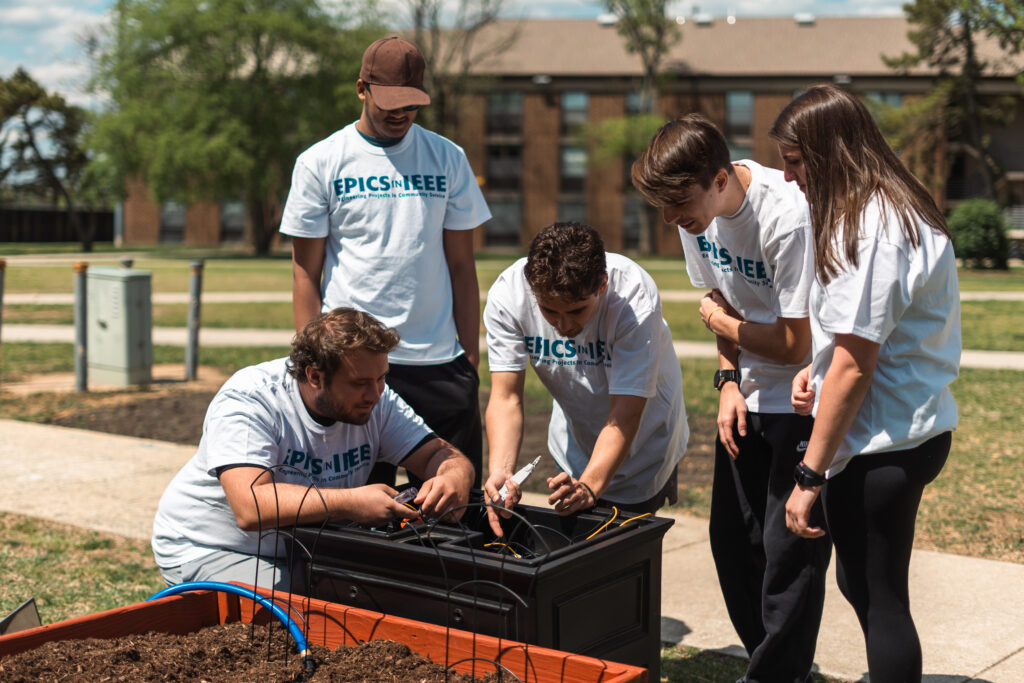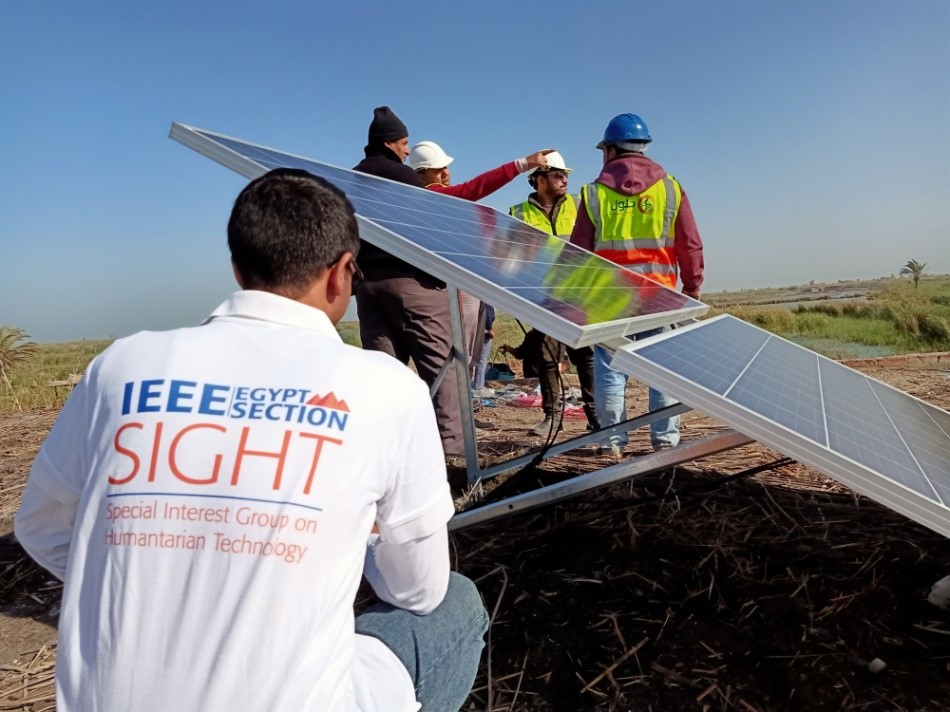IEEE is proud to support two programs that allow IEEE volunteers to give back and have an incredible impact on their community through technology. To better assist applicants who may apply to these programs, below are some highlighted differences. Although there is some overlap, both programs have distinct goals and the below information will help to determine which program is a better fit for your project.

Quick Checklist to Help Determine Where to Submit Your Project Proposal
EPICS in IEEE
- Requires students to be involved from start to finish
- Due to service-learning requirements, proposals must demonstrate how students will be fully engaged in the engineering design process. They cannot be recipients of the project (such as through event participation)
- Student learning outcomes for the project are extremely important
- Maximum project length: 1 year
- Amount of funding: US$500 – US$10,000
- The team must have support from a non-profit community partner organization that will help connect the project team with the end-users and has agreed to help in solution deployment and maintenance.
IEEE HTB/SIGHT
- Students may join project teams, but may not be the primary applicant for a proposal
- Maximum project length: 6 months
- Amount of funding: US$1,000 – US$10,000
- The starting point for a project must be the needs of the community as evidenced through documented relationships with local community organizations and leaders
- No research projects are considered – proposed solutions must apply existing proven technologies within IEEE-designated fields to challenges faced by a localized community
- Projects that are commercial in nature, are purely STEM education-related, or that focus on developing medical devices or medical device prototypes are not considered.
Please continue reading to learn more about EPICS in IEEE and SIGHT, two IEEE programs that provide funding for humanitarian projects.
Student Involvement
The largest difference between EPICS and SIGHT is that EPICS in IEEE  requires students to be involved from start to finish of the project. Students, whether they are university or younger, need to be fully engaged in the engineering design process of the solution being proposed. The EPICS in IEEE program was adopted from the EPICS program at Purdue University in 2009. There is a primary focus on helping students use the engineering design process while incorporating input from community partners and stakeholders. Although our projects are not required to be focused at a university, most of our teams from around the world include university students or are submitted/led by university students. EPICS in IEEE projects can be part of the engineering curriculum or completed through a campus group such as an IEEE Student Branch or HKN Student Chapter.
requires students to be involved from start to finish of the project. Students, whether they are university or younger, need to be fully engaged in the engineering design process of the solution being proposed. The EPICS in IEEE program was adopted from the EPICS program at Purdue University in 2009. There is a primary focus on helping students use the engineering design process while incorporating input from community partners and stakeholders. Although our projects are not required to be focused at a university, most of our teams from around the world include university students or are submitted/led by university students. EPICS in IEEE projects can be part of the engineering curriculum or completed through a campus group such as an IEEE Student Branch or HKN Student Chapter.
The student learning outcomes for an EPICS in IEEE project are extremely important (read the article The Gateway to a Successful Engineering Career including an interview with EPICS founder Leah Jamison). One of the main goals of EPICS is to help prepare students for their engineering careers while also exposing them to engineering for community needs. The student learning outcomes are evaluated closely during the project review process.
 IEEE SIGHT is a program of the IEEE Humanitarian Technologies Board (HTB) and is a global network of IEEE volunteers partnering with underserved communities & local organizations to leverage technology for sustainable development. Since 2020, SIGHT has held its call for project proposals together with IEEE HTB. Students are frequently included in HTB/SIGHT project teams, but may not be the primary applicants of a proposal. An IEEE Member or higher grade member must lead the project implementation to provide guidance and supervision. SIGHT Groups frequently conduct HTB/SIGHT projects, and while project teams are encouraged to form or join a SIGHT Group, this is not a requirement for funding.
IEEE SIGHT is a program of the IEEE Humanitarian Technologies Board (HTB) and is a global network of IEEE volunteers partnering with underserved communities & local organizations to leverage technology for sustainable development. Since 2020, SIGHT has held its call for project proposals together with IEEE HTB. Students are frequently included in HTB/SIGHT project teams, but may not be the primary applicants of a proposal. An IEEE Member or higher grade member must lead the project implementation to provide guidance and supervision. SIGHT Groups frequently conduct HTB/SIGHT projects, and while project teams are encouraged to form or join a SIGHT Group, this is not a requirement for funding.
Funding Requirements
HTB/SIGHT Projects prioritizes support of direct project costs, including necessary equipment, materials, supplies, and travel. No reimbursement of volunteer salaries or honorariums will be provided. No indirect costs will be considered for funding, including but not limited to overhead expenses, honorariums, competition or contest prizes, Facilities & Administrative (F&A) costs, tuition, etc.
EPICS also prioritizes direct project costs and does not fund personnel costs such as salaries, stipends, or honorariums. In addition, EPICS in IEEE does not fund:
- Excessive or international travel, Equipment for personal use
- Research equipment
- Capital Expenses (this includes laptops/computers for computer labs)
- Overhead (including university overhead)
- Miscellaneous (or any additional budget requests that are not itemized)
- Prizes or incentives for participation
- Services such as internet or phone plans (unless not available anywhere in the community for reasonable use)
For both EPICS and SIGHT, the funding is distributed through the local IEEE Section.
Project Length
A logistical difference in the programs is that the HTB/SIGHT project timeline is limited to projects that will be completed within six months.
EPICS in IEEE projects can span up to one year in length. EPICS can support projects spanning multiple years by encouraging teams to break the project up into phases. The initial project proposal is still limited in scope and budget for just the first year and must have clear deliverables at the end of that time that can be tested for success within the community. Future phases of the project that may require additional funding or time for completion can be summarized in the initial proposal to help the reviewers understand the full project scope.
IEEE Engagement
EPICS in IEEE requires at least one team member to be an IEEE member. The IEEE member may be the project submitter such as a faculty advisor, a student member of the project team, or a professional member of the project team. EPICS in IEEE encourages teams to work with IEEE units such as local sections and IEEE Student Branches.
HTB/SIGHT projects should have strong connections with local IEEE organizational units (OUs) and engage a significant number of IEEE members currently living in the country/countries where the project is to take place.
Community Partner Engagement
EPICS in IEEE requires that a non-profit or non-governmental organization (NGO) community partner be involved throughout the project and engage in the engineering design process so that the students understand the needs of the end users. EPICS requires at least one non-profit organization that works directly with the stakeholders benefiting from the project to be the main community partner. The non-profit/NGO should be working in an area that is related to the scope of the project’s proposed problem and/or solution. For example, a local village council would not be approved by EPICS in IEEE as the nonprofit partner, but a nonprofit that focuses on hygiene and medical needs within various communities would be an appropriate partner for a project focused on hygiene in that rural community. If the project needs a physical installation in the local community, the team should provide an additional letter from the local village center that clarifies they agree to allow the device to be installed and used on their property.
HTB/SIGHT project proposals must clearly articulate how the project addresses a pressing need of their local community. The local community must be actively involved in determining what is needed/desired and how a project will be designed and executed. Projects must supply letter(s) of support from the community to demonstrate this. Letters from a community entity could be from an NGO, local government official or ministry representative, school, medical clinic, village association, neighborhood council, etc. Applications must clearly outline who the stakeholders affected by an intervention are and what educational efforts the team will undertake so that the local community is engaged throughout the project and ready to ensure its sustainability after deployment.
For both EPICS and SIGHT, engagement with the community before submitting the proposal is critical to being able to write a strong proposal. The project summary should summarize the needs of the direct community you are planning to work with, and the letter from the community should be specific concerning how they plan to engage with the project, as well as if they are providing any resources for the project.
Call for Project Proposals and Selection Process
Currently, EPICS in IEEE is offering calls for proposals 2-3 times a year. Some project calls are themed and only review projects within a certain project category. Others are open to all types of project submissions.
HTB/SIGHT sets a schedule for calls for proposals on an annual basis. There is typically a call for proposals open to all active IEEE Members at the beginning of a calendar year (March or April). HTB also hosts multiple collaborative calls for project proposals with other IEEE organizational units (such as Societies and Regions) throughout the year for members who meet certain criteria.
Both programs have committees that review projects in a multi-stage evaluation process and engage with project submitters to gain additional clarity or quick responses to questions via email when possible. If a project is not selected for funding, feedback is provided to help the team strengthen future submissions. Both groups are selective, and weak proposals will not be selected for funding.
Summary
Hopefully, this information helps differentiate these impactful programs. The best way to write a successful proposal to either program is to read the detailed proposal information and ensure you are meeting all project requirements in your submissions. Often a proposal written for one program will not score well on the rubric for the other program because the proposals have different questions and focus.
Both programs have submission deadlines throughout the year. Visit the EPICS in IEEE website and IEEE HTB website for more information on current funding opportunities. If applicants are unclear on which program they should submit to, please reach out to epicsinieee@ieee.org.

Recent Comments